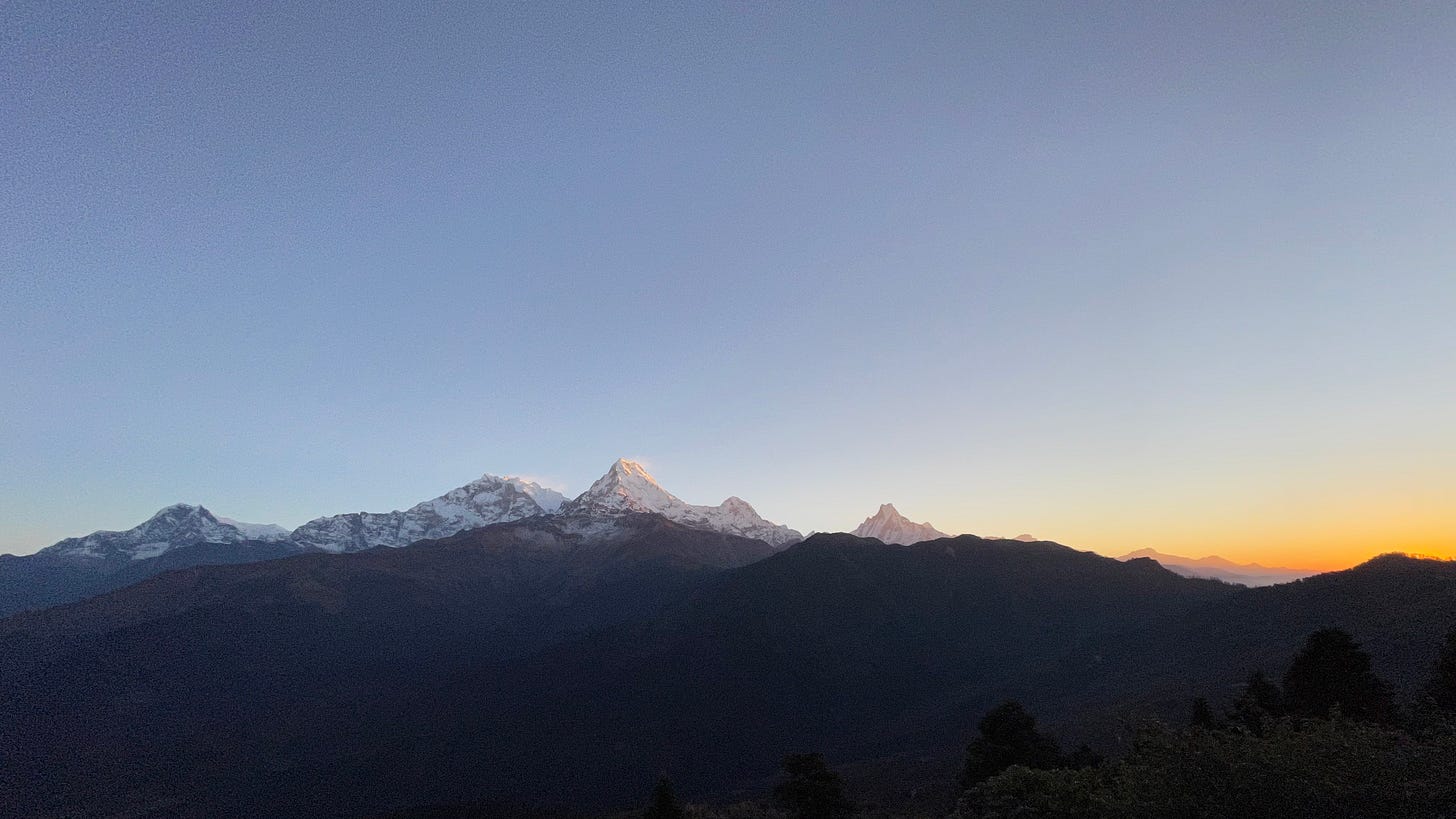
We began our trek from Nayapul, a common starting point for many treks in the southern Annapurna area, though in truth we didn’t start walking from there. Our jeep took us a bit further up the dirt road, bumping over rocks past hikers who had gotten earlier starts than us. The car stopped by a small tea house and let us out into the warm, late morning sun, where we put on our packs, tied our shoes, and then started up the stairs.
The rhythm of trekking returned to me quickly, and I curled up into it like a warm blanket. Trekking in Nepal is like nothing else: there are sacrifices to be made, of course, but not many. The trails can be steep and difficult, but guides and porters are there to help, and there’s a village every few hours brewing a hot cup of tea with your name on it. At the end of the day, a scenic tea house is there waiting for you, with beds, blankets, pillows, and in the more popular areas, a hot shower and even wi-fi. It would be a glamorous way to hike anywhere in the world, and it’s certainly no less so beneath Himalayan skies.
Our group was eight people in total, four Americans and four Nepalis: myself, my dad, his friend Bob, and his daughter Ada; Ngima, our guide, Rinji, his assistant, and Pema and Pasang, our two porters. Our Sherpas (I mean this both literally and figuratively, since they all actually belong to the Sherpa ethnic group) were kind and patient, the two guides bookending the group as we walked and the porters running ahead to wait at long intervals for us to reach them. Ngima tended to lead the way, with Ada and I (as the younger ones) following right behind, while Rinji stayed in the back and let my dad slowly chip away at his quiet, serious demeanor.
We hiked for a few hours on the first day, and then came to a village where we stopped for a hot lunch. It was already busy on the trail—the Annapurna Conservation Area is the second-most trafficked trekking area in Nepal, after the Everest region, and it’s peak season. People of all sorts were all over the trail, from grandparents to children, some in huge groups and some going solo, moving quickly or slowly, Nepalis and foreigners, speaking dozens of languages as they walked. Porters piled high with duffel bags zoomed by us up the stairs, families stopped to take pictures, tourists with huge backpacks and sunglasses kept their heads down, guides chatted with each other about their routes and their clients while waiting for the latter to catch up.
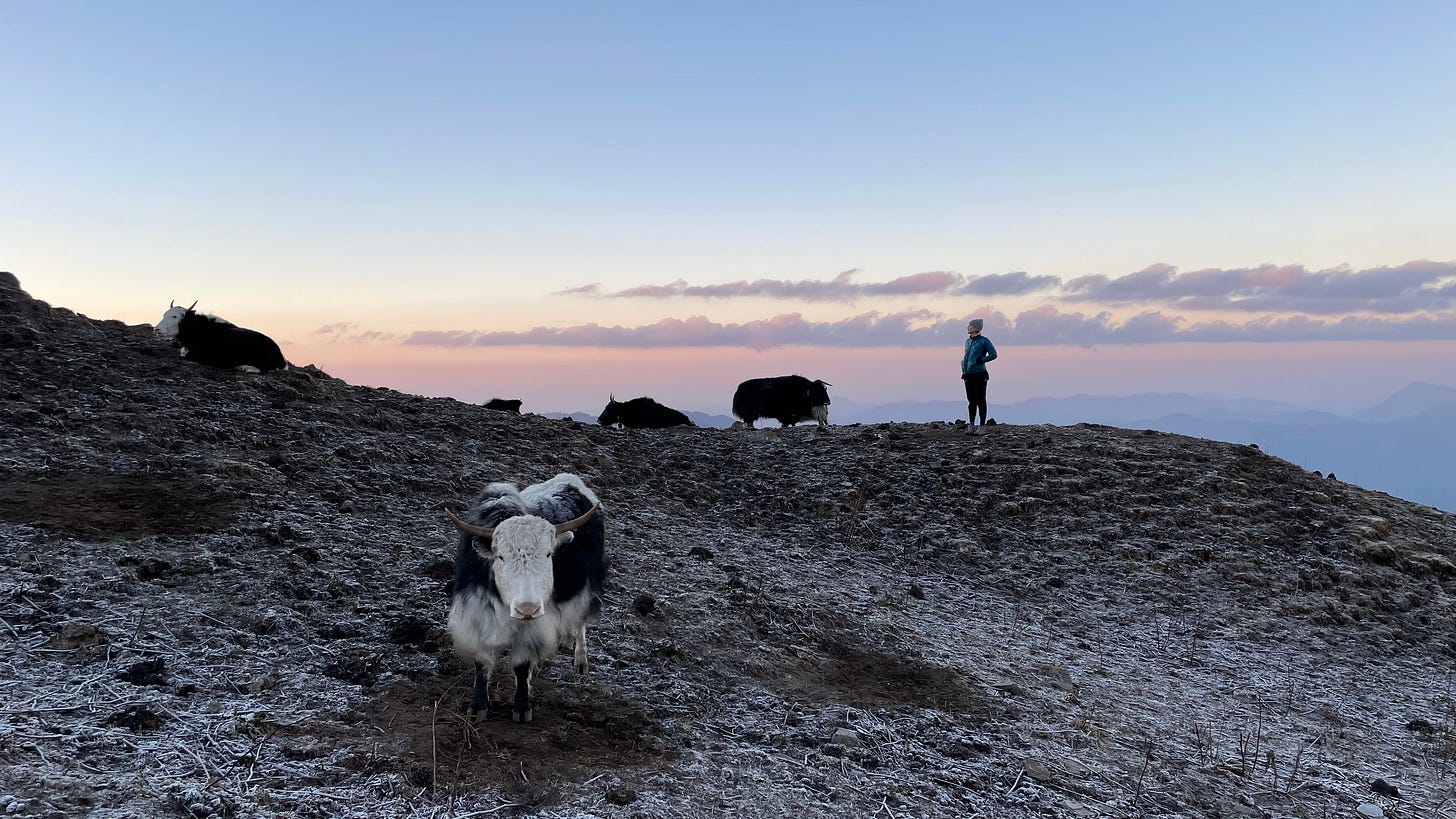
After so long in the hot, dusty city, I was grateful for every little piece of my surroundings, none of which were lost on me. The weather was perfectly mild as we made our way up into the jungle, luxurious in the sun when the breeze blew by and peaceful in the shade as long as there was no wind. Since the monsoon had just ended, the trees were lush and green, coming together into thick hillsides, and I thanked them with every deep breath I took. The streams we passed poured down over rocks and shattered into a million gems that each looked sweet enough to drink without filtering (though our guide advised me against this). It seemed impossible that we could be geographically so close to Kathmandu and yet on a different planet.
Our first night was in a town called Ulleri, perched up on a ridge that we earned with a long, sustained hike up about two hours of stone steps. At our tea house, we settled into what became a common routine every day for the rest of the trek, looking for bits of snow in the distance as we sipped tea, quietly watching the sun set among layers of ridges and flaming clouds, sitting in a warm dining room playing cards or reading a book, braving the cold outside for as long as we could stand to catch a glimpse of the stars on the walk back to our rooms. I could feel the time slowing down around me, the peace settling into my bones.
And from there it only got better, hiking up to more villages, through trees and over hills, for seven days. Every afternoon we came to a new tea house in a new beautiful location, and we watched with admiration as the hues of the hills changed from green to violet. Every morning we woke in awe to find not a cloud in the sky, our surroundings having transformed overnight, massive mountains that looked as surprised as we were, as if they had been transported there while we were asleep. How could these giants have been waiting just behind those clouds, so close to us the whole time?
On the morning of our third day, we woke up early to take the short hike up to Pun Hill for sunrise. Accompanied by what felt like hundreds of other hikers, we made our way up to the famous viewpoint with the stars spread like a carpet overhead and found a clear spot to stand. The tower was full of people even though it was still more than half an hour until sunrise, and the snack shack was churning out hot coffees by the minute. I spent the first few moments excitedly pointing out peaks and confidently but incorrectly identifying them to anyone near me, then soon fell quiet and watched as the sun slowly, slowly lit the sky and crept onto the mountains. When the rays hit the snow, steam gently began to rise into the cloudless sky, and there was nothing to do but grin shamelessly at the giddy beauty of it all.
I could’ve stayed there for hours, watching the sky slowly fill with clouds, and I did stay there until the entire world was light, but we had more walking ahead. We turned off the beaten track, leaving behind the Annapurna Base Camp-bound crowds, and hiked towards the mountains on some newer trails. The path was spotted with hollow, black tree trunks from recent forest fires, and one section had been recently hit by a landslide, so we had to carefully climb up the fresh soil on hands and knees. When we reached the next tea house, the amenities were fewer, but once they got the wood stove burning I had no complaints.
We passed through so many stunning environments, from hot, low jungle up through twisted rhododendron trees and mossy pine ridges, eventually coming up over the trees and into the clouds. In the space between the snow and the trees, streams poured through raw valleys to form waterfalls among the low, striated grass and the bare rocks, while donkeys and yaks grazed peacefully and murky, landlocked lakes bore witness. There’s something special to me about that place, where the wind whips my face red and the clouds curl around me like an old friend. It’s a place of extremes: uncomfortable as the hail that fell on us as we walked up the steep trails, the deep cold at night and the thin air, but a beauty entirely of its own.
In the end, the trek was just as much about the amazing views as being there with my dad. We had been planning this trip together for a while, basically since I knew I was going to be coming to Nepal, and he knew that it would be difficult for him. He spent months training and getting ready so that he could be here with me to do it together. There were lots of groups of older tourists on the trail, but when I watched my dad (age redacted) walk by them, I kvelled knowing that that was my dad accomplishing something so impressive. Despite not walking the whole thing side by side (or him necessarily enjoying the walking), he got through it. No, he more than got through it: he pushed himself to do something that not many could do and succeeded without a complaint, and I’m unbelievably proud of him. Bob and Ada were wonderful company too, of course, but—my heart could burst writing this—getting to travel with my dad was priceless. As he said so many times, it’s all about making memories.
On our last night, we came to a true village—not just a collection of tea houses, but a place where people really lived, filled with houses and terraced fields bright with flowering millet and barley swaying in the breeze. As we entered, we walked straight through a school yard where people were dancing and feasting, belatedly celebrating a wedding from months ago. I lay in the sun at our tea house later, soaking up the warmth, aching with a bittersweet feeling that I’ve come to know well. Traveling through these small, rural places fills me with joy, but along with that joy comes a longing to stay there, the thought that this could’ve been my home, and how wonderful that would be.
A jeep came to pick us up the next morning and juggle us down the road (I learned that four people in the middle row is actually more comfortable for that kind of ride, since there’s less space to be thrown around). We only passed one huge truck on its side before coming to the main road, which winds through one of the world’s deepest gorges all the way up to Tibet. Taking a left, we headed back down to Pokhara, cliffs and waterfalls and an energetic river keeping us entertained all the way down. I knew we were almost back when we came around a turn and suddenly the hills in the distance were hazy with dust.
Even though we were only in Pokhara one night, it was just after the start of Tihar (also known as Dipawali), the Nepali Hindu festival of lights, and the town was buzzing with holiday cheer. Buildings were decked out in twinkling lights for Lakshmi Puja, the day of prayer to the goddess of wealth and good fortune, and we dodged painstakingly made sand mandalas on the sidewalk as we walked to dinner. Groups of kids were gathered around people doing traditional dances in the street, and there were even some bands playing live music while their friends cheered them on. It was an easy night to be happy.
To break up our drive back home, we stayed in Bandipur, a small Newari town on a hilltop just off the Kathmandu–Pokhara highway. Home to the only (allegedly, though believably) traffic-free bazaar in Nepal, it was charming and picturesque, a peaceful place to wander around and stop over for the night. We caught a faint sight of the Manaslu mountain range in the distance as the sun set, and soon people were in the streets celebrating with music and dancing once again. In the morning, we took a quick hike up the hill that looked down over the village, but the air was thick with dust and pollution that made it hard to see anything beyond that.
Upon returning to Kathmandu, everything was a blur: the big city with its roaring cars and seas of people, my days restful but suddenly empty, the hours counting down until my vacation was over. Tihar continued, and the streets were lit up brightly, filled with people on holiday. After dinner by the Boudha stupa, one of the largest in the world, we walked through crowds of young Nepalis who had started gathering outside around bands playing songs that everyone seemed to know. We happened to stand right in between two bands playing at the same time, and as we got caught up in the singing and the dancing, I remembered that there are times here, even in Kathmandu, when I can feel blissful and fulfilled.
After just one full day of rest, our friends Bob and Ada departed for another trek, leaving me and my dad in the city. We had very few real plans for our last few days together, which gave me plenty of time to avoid thinking about the immediate future, that is, the end of my vacation and my return to daily life at school in Kirtipur. We enjoyed one last big treat together: a mountain flight, starting and ending in Kathmandu, offering views of the stunning peaks north and west of the city and guaranteed window seats for its one-hour duration. Despite clouds in the city, once we broke through we saw nothing but clear skies and peaks stretching forever into the distance. We got a look at the Big Guy too, but, you know… no spoilers.
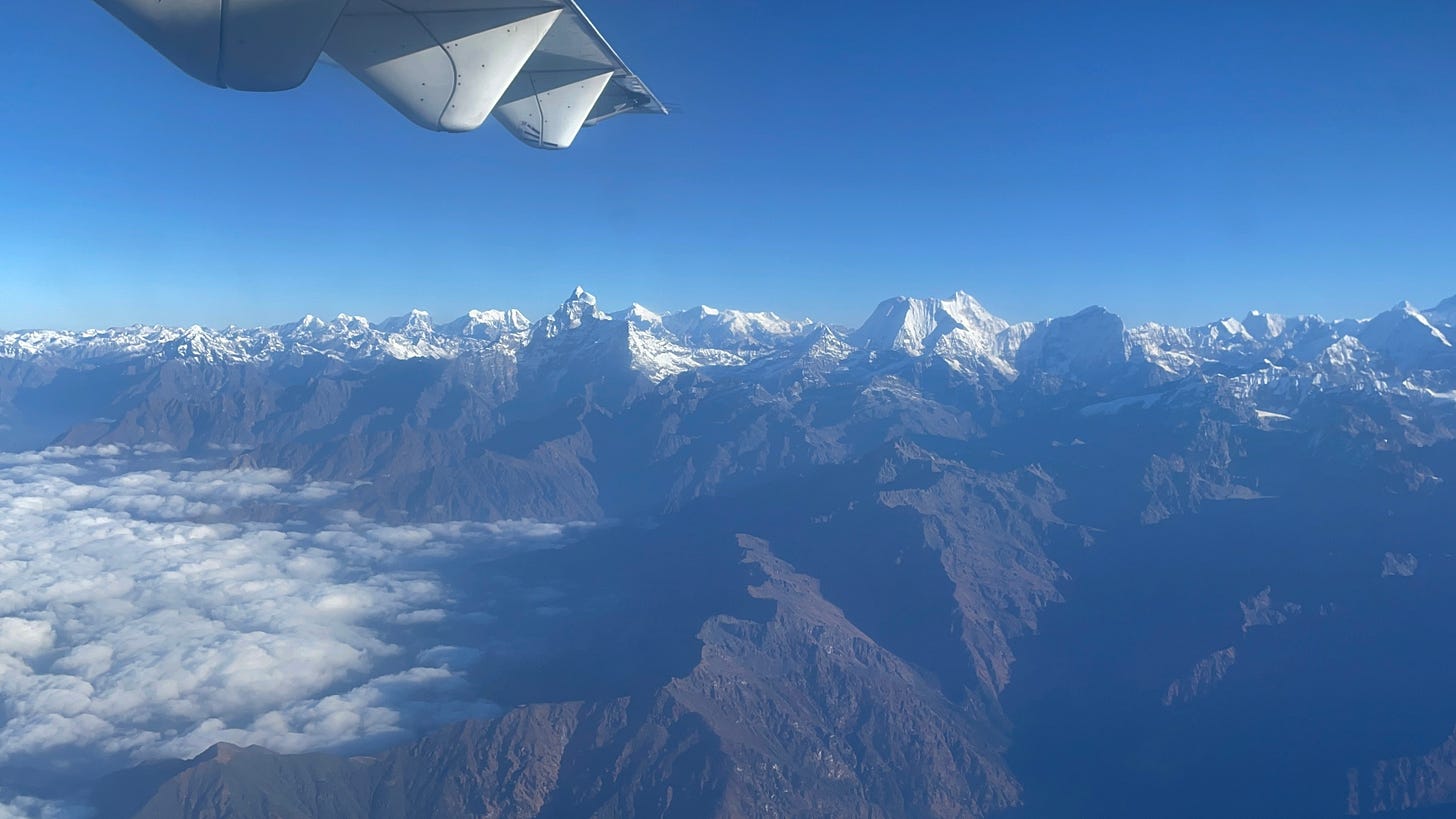
As cool as I might’ve seemed, watching soccer on TV, buying last minute gifts, and strolling around looking for a good spot for dinner, I was slowly cracking on the inside. This vacation left me speechless, and my dad was here with me for all of it—from the day of my last school program until the night before I went back. The truth is, when that last day came, I wasn’t quite ready to say goodbye. We went out to eat together and talked, but I was hardly hungry with the pit in my stomach. For the first time here, I felt genuinely homesick, and part of me was ready to get on that plane with him and head home.
But instead I called my cab, hugged my dad as tight as I could, and headed back to my other home. My driver left me alone, and I put in my headphones as I got thrown back and forth avoiding potholes. Back at my host family, my brothers were waiting, excited to see me after so long. When I said goodnight and got into bed, I couldn’t help but wonder: what’s going to get me through now? This vacation was what I thought of during the long summer months when I needed hope, and as fast as I know the next months will go, I need something new to put my hope in. At the same time, lying in the dark, I remembered how much I’ve struggled with gratitude here, and I realized how grateful I really am, how lucky to have people that I can miss this much. Slowly, somewhere between those two thoughts, I fell asleep, ready for the days ahead.
Until next time: peace!
Much love,
Oren



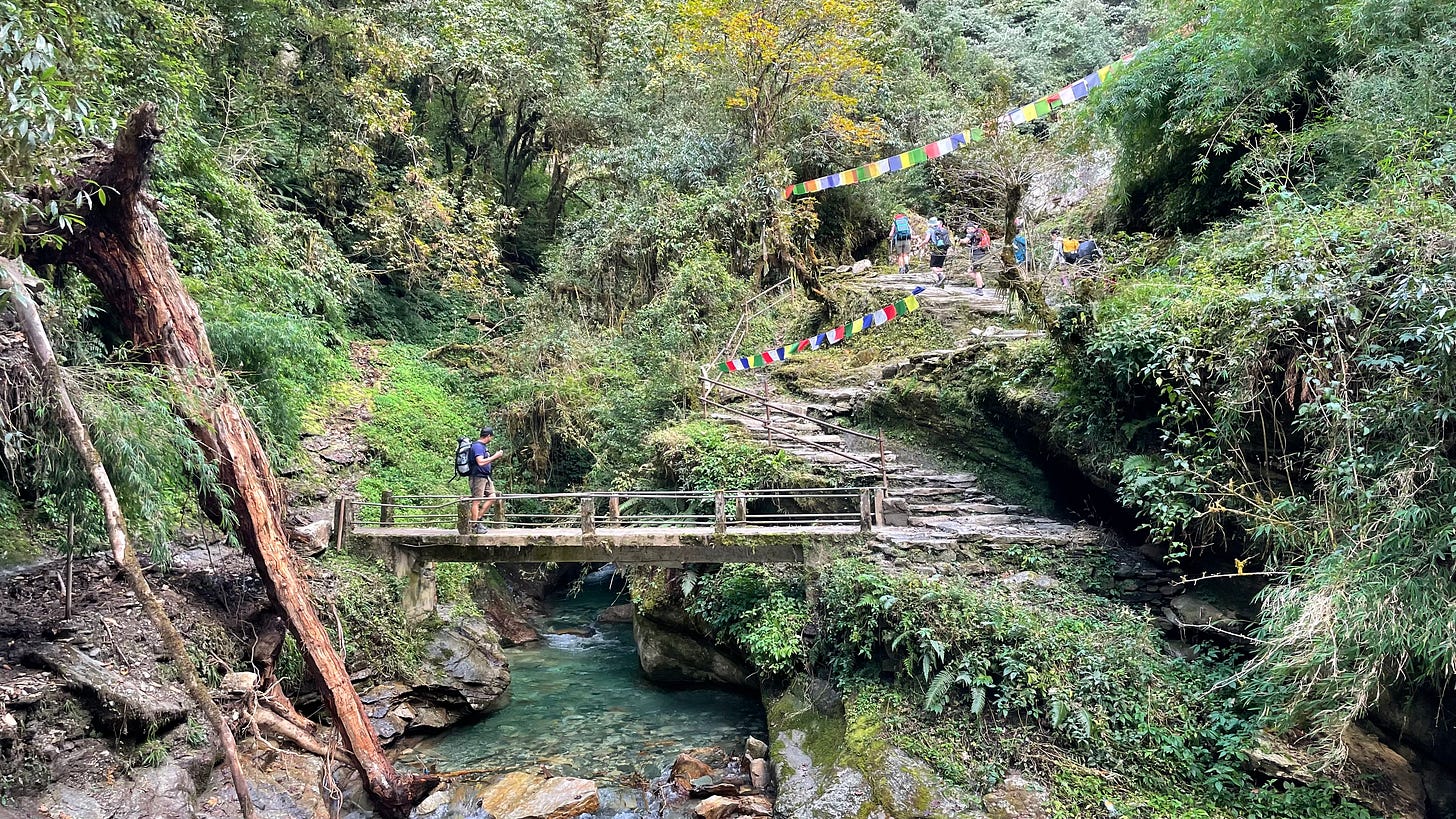
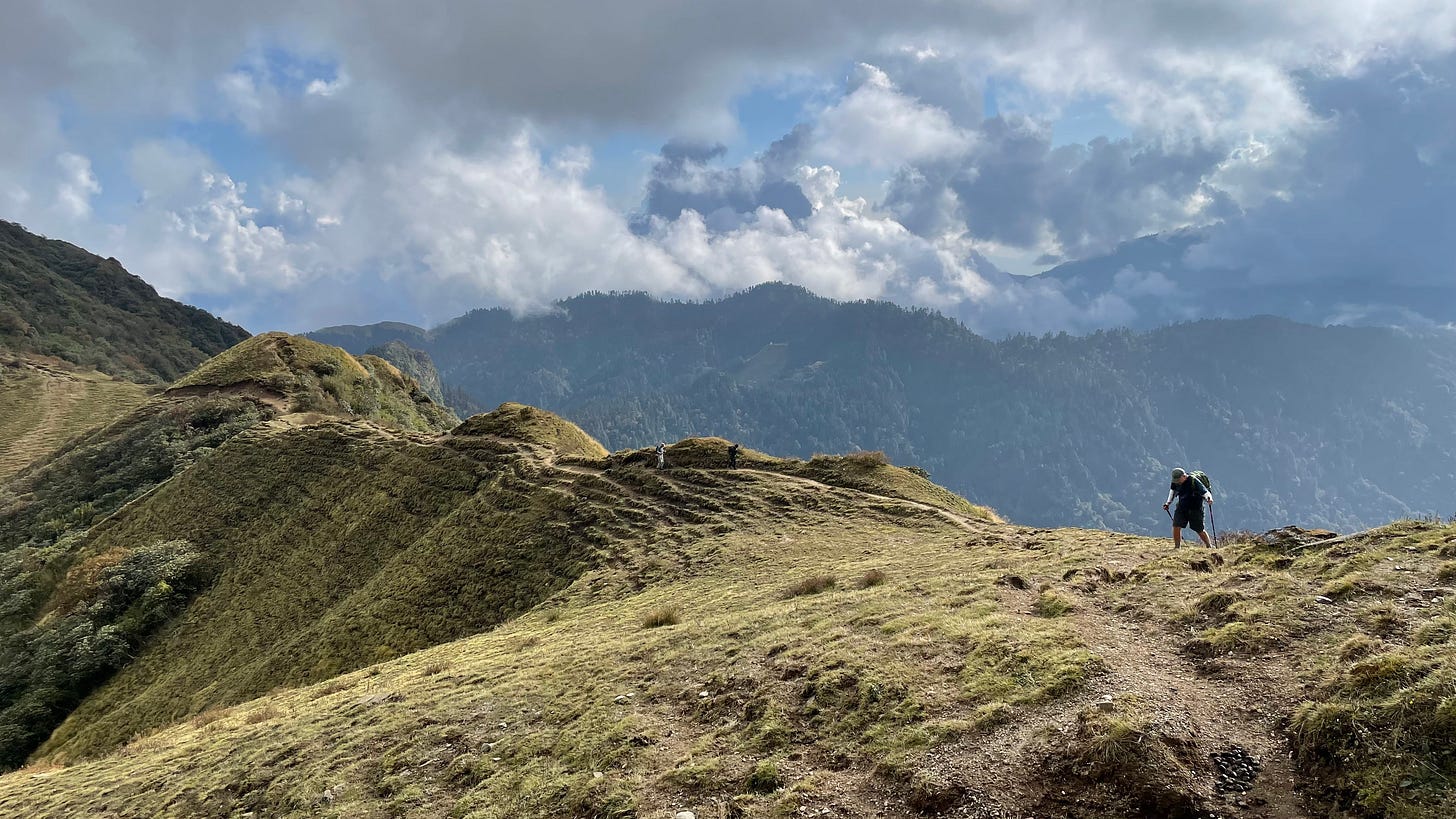

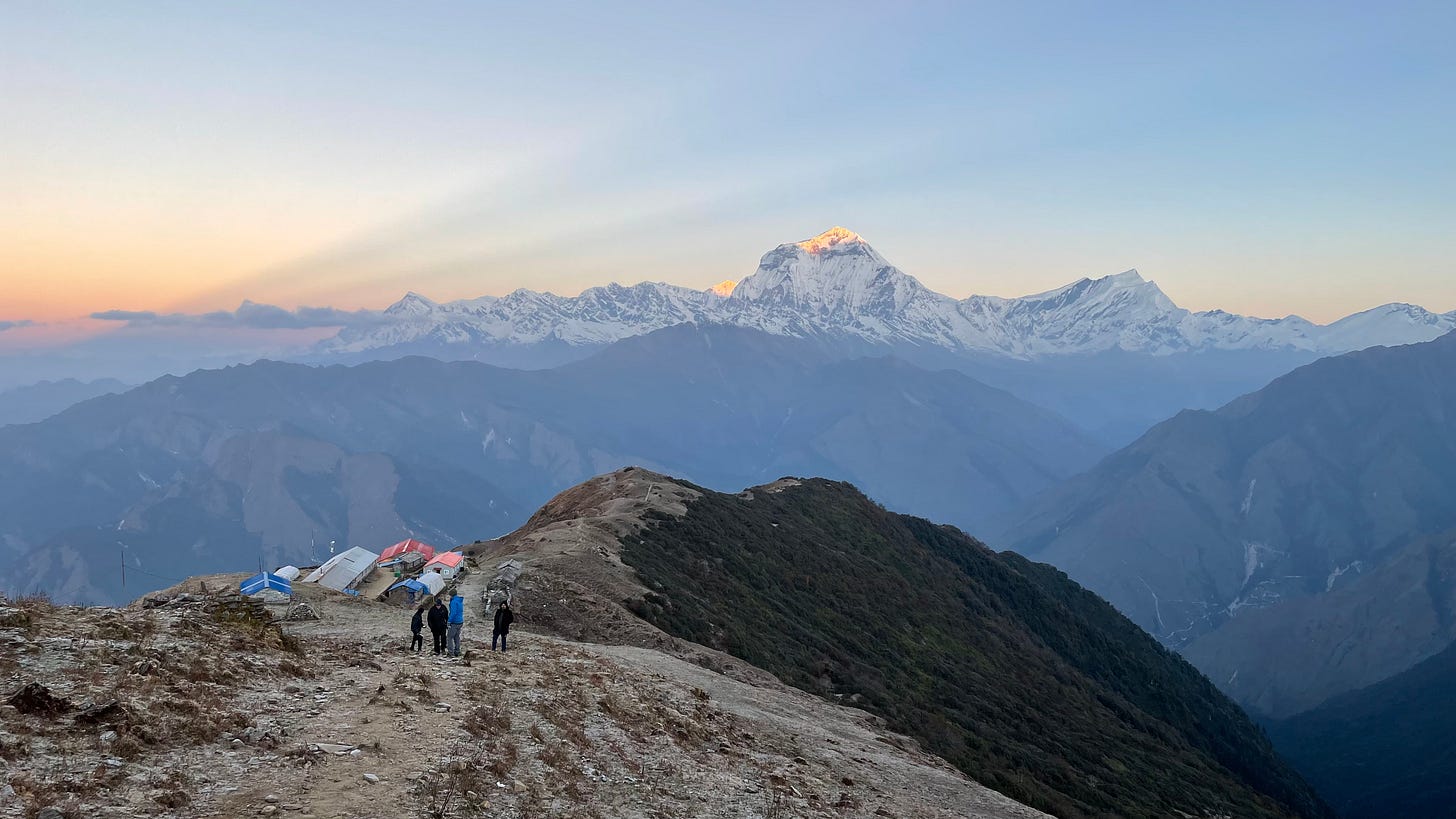
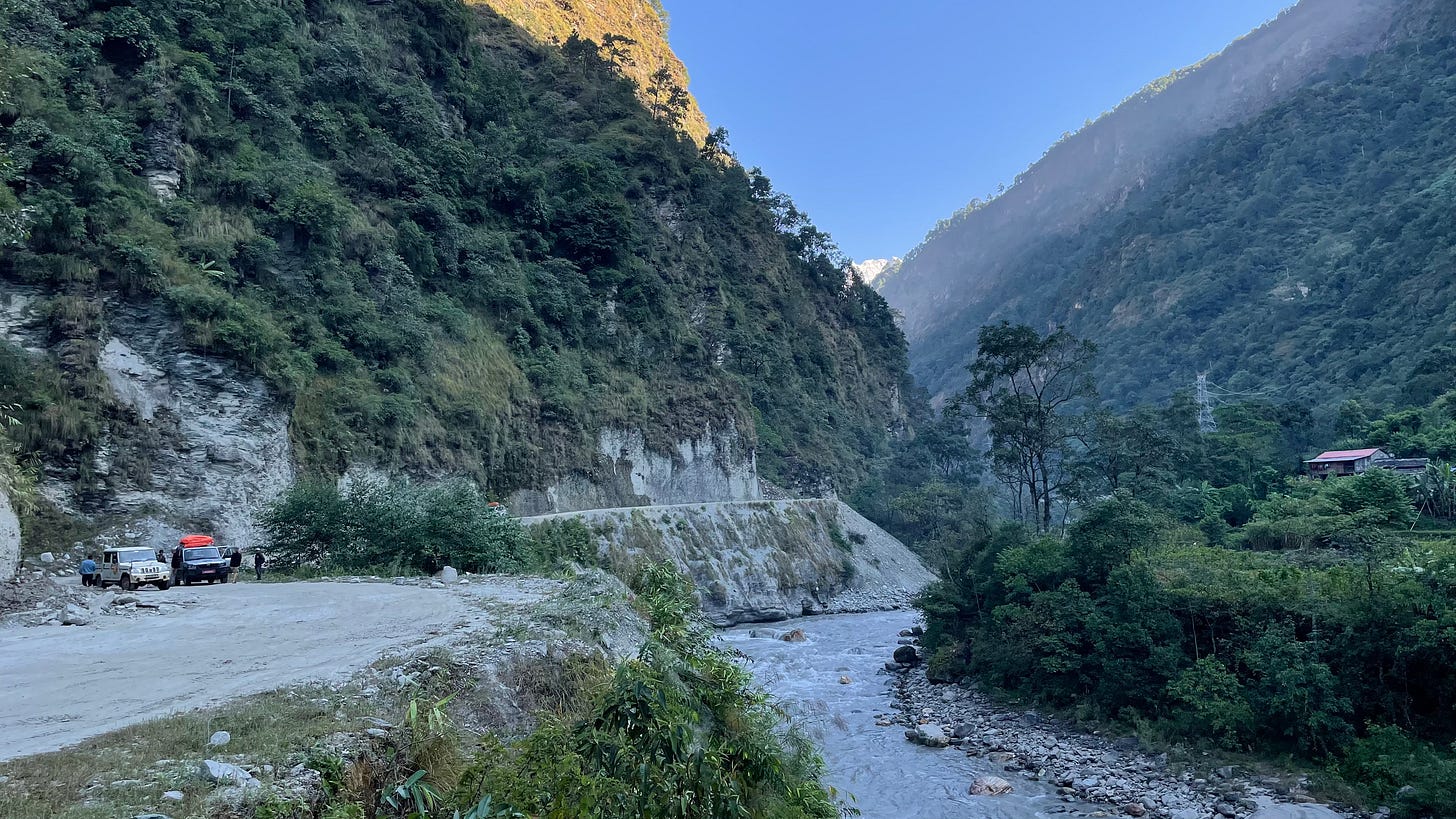
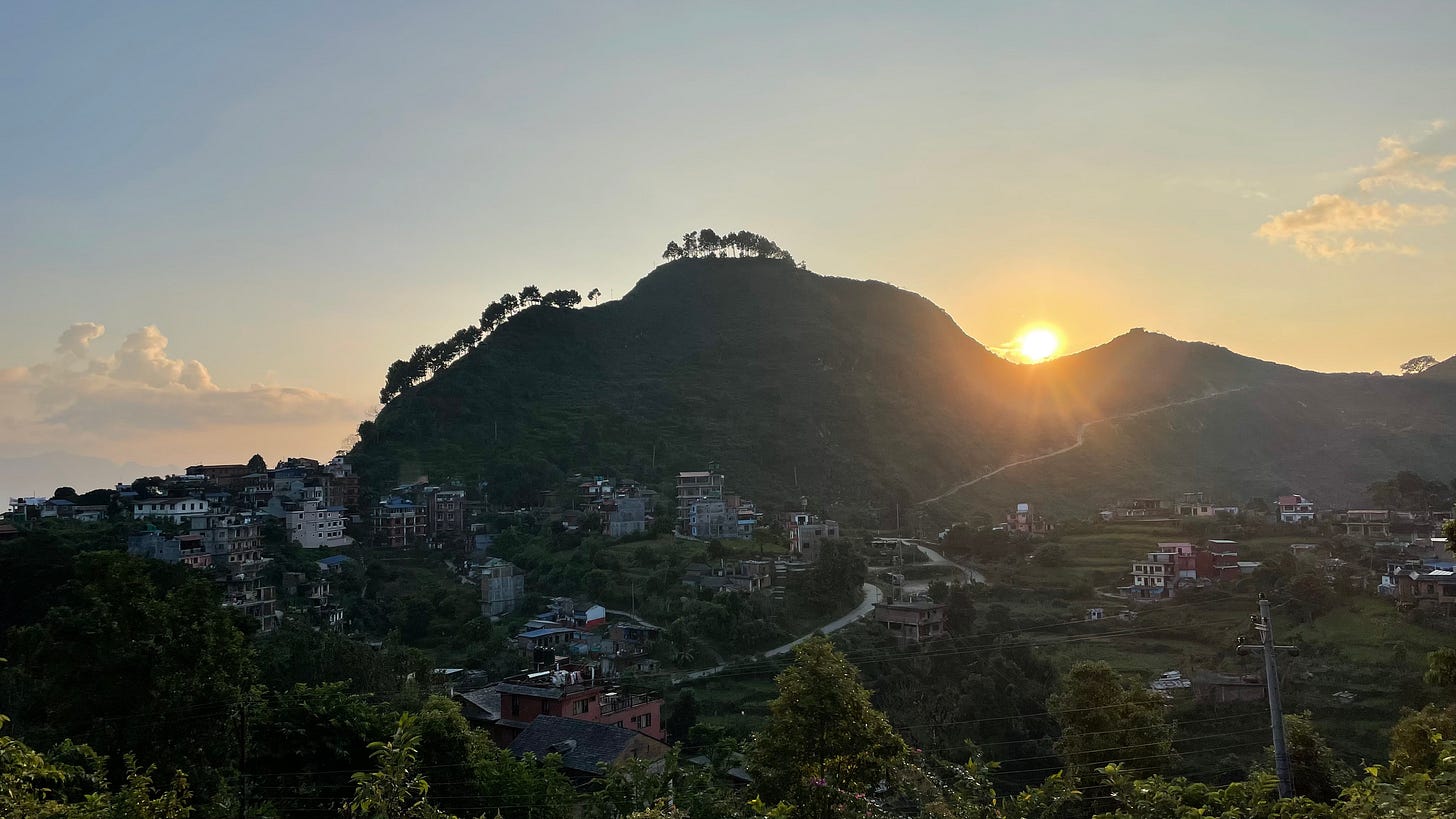

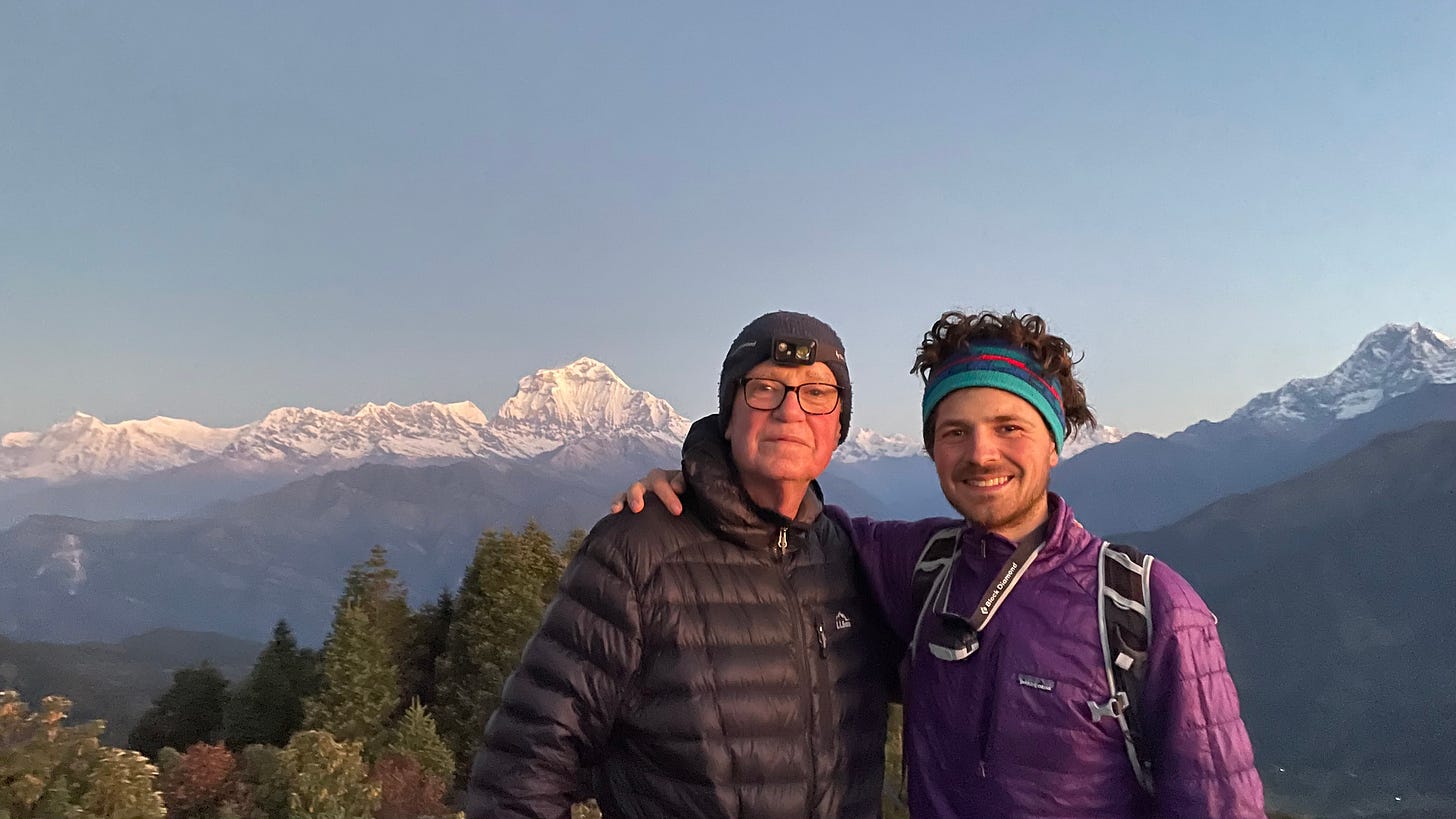
Hi Oren! This is beautiful and I have loved reading your blogs! I have meant to respond a few times (maybe I did once but I might have gotten interrupted) but here I am finally sending a note to say thank you for sharing so many of your experiences thru these blogs! I'm so glad you had a great time with your mom and dad and that all the travels were wonderful and safe and have filled you up. I know you'll soon get very busy with school and before you know it, your time will be winding down. I look forward to your next blog! XOXO
Ah, there must be saying somewhere about the enlightenment that cones from difficulty. I’m so glad you had a great time with dad!😘